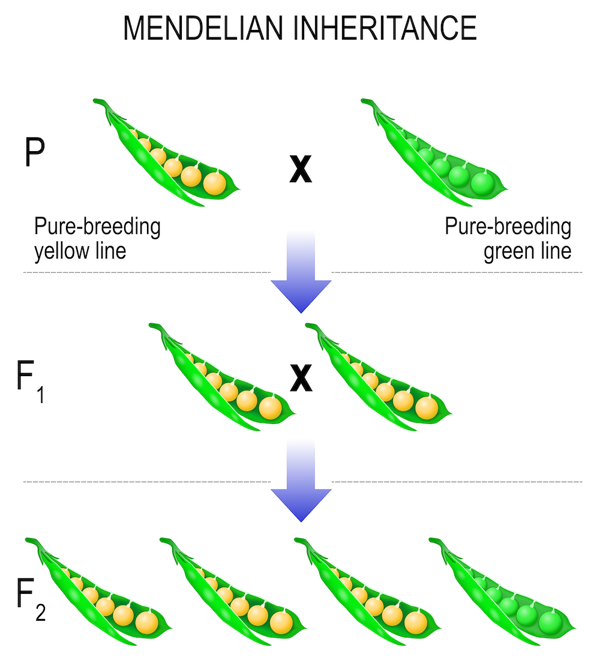
What is Mendelian genetics?

- Related Topics:
- Common questions,
- Classical genetics,
- Dominant and recessive,
- History
A college student asks:
"What is Mendelian genetics?"
This is an excellent and absolutely quintessential genetics question!
Mendelian genetics is named after Gregor Mendel. He was one of the first scientists to identify some basic patterns of inheritance. His work is foundational to our understanding of modern genetics, which is why he’s sometimes referred to as the “Father of Genetics”.
Scientists use the phrase Mendelian genetics to describe things that follow the basic rules Mendel discovered. This includes traits that are entirely determined by one (or two) genes, which follow predictable inheritance patterns. You may also hear this referred to as “classical genetics”.
Today, we know a lot more about genetics than Mendel did. And it turns out that most traits are more complicated than just one gene. Some traits are affected by dozens — or hundreds! — of genes, while others may be affected by other external, environmental factors. This may be described as non-Mendelian genetics, complex traits, or multifactorial inheritance.
But let’s dive more into what Mendel discovered, and how it can still help us better understand genetics today!

Gregor Mendel and his peas
You may have heard people say that traits like hair color and eye color often run in the family. Or maybe you’ve noticed that it's common for children to look similar to their parents, and wondered: why does this happen?
Back in the mid-1800s, Austrian biologist (and monk!) Gregor Mendel was asking himself that same question. Why are certain traits passed down from parents to their offspring? What rules govern this process? In search of an answer, he began observing and documenting the traits of everything from honeybees to mice! He eventually found himself studying garden pea plants, mainly due to how quickly they grew and how easy they were to control.
By controlling which two pea plants he bred together, he could observe their offspring and look for patterns. After repeating these experiments with pea plants thousands of times, he noticed some striking similarities in the ways different traits appeared in offspring.
Mendel looked at some specific traits in his pea plants, including: the color and shape of the peas, the color and shape of the pods, the color and position of the flowers, and the overall plant size.
He was shocked to find that for all these different traits, there was always a specific version that would conceal the other version. For example, if a pea plant with yellow seeds is crossed with a plant with green seeds, then their resulting offspring will all have yellow seeds. None would have green seeds.
He then discovered that if he crossed those yellow seeded plants together, their offspring would have a mix of yellow and green seeds. The green color had somehow reappeared!
Mendel also counted all his plants and kept track of the results. From this, he noticed that the “hidden” trait always reappeared in about 25% of that generation.

Mendel’s three laws of inheritance
The result of these experiments were Mendel’s three laws of inheritance, the first of which we’ve already started addressing!
- Law of Dominance and Uniformity
This first law addresses why some traits were “hidden” or appeared to “skip” generations. Nowadays, we know that the trait that conceals or “covers up” the other trait is referred to as dominant, and the trait that is covered up is called recessive.
Mendel’s first law states that when plants with different traits are crossed together, only one form of the trait appears in the next generation. The resulting offspring will all have the dominant trait. - Law of Segregation
Mendel’s second and third laws are related to what happened in that second generation. Why did the recessive trait reappear? And why did it always reappear in 25% of the offspring?
Mendel came up with the idea that the plants had “hereditary factors” that determined these characteristics. From his observations, he determined that each characteristic (like flower color or seed shape) came in two different versions.
Today, we use slightly different words that you may already be familiar with. Mendel’s “hereditary factors” are now called genes, and different versions of genes are called alleles.
He also determined that a single plant would have two copies of the gene for that trait. Those two copies might be identical, or they could be different. So a single plant could have two yellow seed alleles, two green seed alleles, or one of each.
His second law states that a parent will only pass one of these alleles to their offspring. - Law of Independent Assortment
Mendel also noticed that the different plant characteristics were inherited separately. Whether a pea plant inherited green or yellow seeds, that would have no effect on what flower color it inherited.
In more formal terms, his third law states that the alleles of two different genes are sorted independently.
All three of these laws were groundbreaking for their time. Back then, most people assumed that traits were inherited by simply blending the traits of the two parents. Mendel’s pea plant experiments laid the groundwork that modern genetics would develop from over the following centuries. As you can see, there’s a LOT you can learn just by looking at the plants in your garden!

Exceptions to the rules
As the centuries have passed we’ve learned that while these rules may be true for many of the traits Mendel observed in his pea plants, they do not always represent the whole truth…
- Law of Dominance and Uniformity
While Mendel’s understanding of dominant vs. recessive still holds true to this day, we now know that it’s often much more complicated. Some traits are affected by lots of different genes, affected by non-genetic things, or both. Complex traits like this are actually more common than simple dominant/recessive traits.
Take height for example. While a person may have tall parents, that does not necessarily mean that they will be the same height. In fact, we know that not only are there multiple genes that can affect height, but also a number of other biological and environmental factors as well! So sometimes it’s not as easy as Mendel made it seem.
- Law of Segregation
Second, we know the law of segregation is not always true either. Sometimes one parent passes down two copies of a gene to their offspring. This is called nondisjunction.
An example of nondisjunction you may be familiar with is Trisomy 21, also called Down Syndrome, in which a person has three copies of chromosome 21! They inherit one copy from the first parent, plus two copies from the second parent.
- Law of Independent Assortment
Lastly, we now know that the Law of Independent Assortment isn’t 100% true either. While it is true most of the time, sometimes traits are inherited together! For example, if two genes are located right next to each other they might be inherited as a pair. This “buddying up” of genes is called linkage. Thus, the inheritance of alleles on separate genes is not always so separate after all!
In Conclusion
All that to say, Mendelian genetics refers not only to these three rules, but to the experiments they came from and the ever-evolving field of genetics that followed them! Thank you for joining me through this scientific journey across centuries. I hope you learned something new about the field of genetics (and some of the people and ideas it grew from) along the way! If you’re still hungry for more, check out some of the other amazing articles written about Mendelian genetics and other patterns of inheritance!
Read More:
-
Article about predicting eye color: Is it possible to predict what color eyes my child will have?
-
Another article that discusses Mendelian traits: How is it possible that my earlobes are free when both my parents’ are attached?
-
Learn more about pea plant experiments! If we cross a heterozygous pea plant, could we get both yellow and green peas on the same plant?
-
Learn about blood type inheritance! How is blood type inherited? And do exceptions ever happen?
-
This is a great article to learn more about X-linked inheritance: Could X-inactivation cause a heterozygous female carrier to be colour blind?

Author: Ben Esmaili
When this answer was published in 2023, Ben was a M.S. candidate in the Stanford University School of Medicine, studying Human Genetics and Genetic Counseling. Ben wrote this answer while participating in the Stanford at The Tech program.
 Skip Navigation
Skip Navigation
